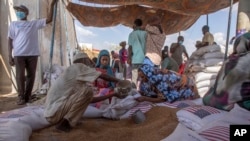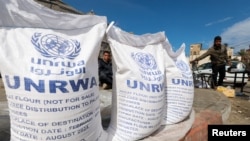Facing potential budget cuts this year, the U.S. Agency for International Development (USAID) — the world's leading humanitarian donor — says it may need to curtail its response to global crises.
President Joe Biden's proposed budget for the current fiscal year asks for $10.6 billion in humanitarian aid as part of its overall foreign assistance spending, much less than was actually disbursed in each of the past two years. Congress has yet to finalize a budget for the fiscal year, which began last October.
U.S. spending on humanitarian aid reached a record $17 billion in 2022, largely in response to Russia’s invasion of Ukraine, and stood at $15 billion in 2023. Both years, the disbursed amounts were significantly higher than originally budgeted, due to supplemental authorizations from Congress.
“In FY 2024, we expect total humanitarian assistance obligations to be less than last year, which would require USAID to reduce funding for nearly all of our crisis responses compared to 2023,” a USAID spokesperson told VOA this week in written comments.
USAID is responsible for managing most of the government’s humanitarian assistance.
Despite projections, the budget figures can and sometimes do change during the course of the year.
For example, the Biden administration requested $10.5 billion for humanitarian aid in fiscal 2023, and Congress approved only $8.6 billion. Nevertheless, supplemental appropriations during the year pushed the total up to nearly $15 billion, with a large share going to Ukraine.
The USAID spokesperson said the agency is still hoping that Congress will agree on a national security supplemental appropriation for fiscal 2024. Otherwise, “USAID will have no choice but to make critical cuts to lifesaving programs.”
UNRWA funding suspension
In January, the U.S. and some of its Western allies suspended funding to the U.N. Relief and World Agency for Palestinian Refugees in the Near East (UNRWA).
Historically, the U.S. has been UNRWA's largest contributor, donating between $300 million and $400 million annually.
This decision came after Israeli officials alleged that several UNRWA employees were involved in a Hamas terrorist attack on Israel on October 7, 2023. UNRWA fired the accused employees and initiated an investigation into the allegations.
With 13,000 employees in Gaza, UNRWA is the largest and best-equipped agency to deliver aid to the enclave, where the U.N. says hundreds of thousands of people face catastrophic levels of hunger. However, some U.S. lawmakers have warned they will block any resumption of aid to UNRWA.
“A dollar for UNRWA is a dollar for Hamas terrorism,” Republican Representative Brian Mast wrote on X last week.
However, the USAID spokesperson said the American agency has a great deal of latitude in how it spends the money allotted to it.
"USAID’s humanitarian funding from Congress is fully flexible, allowing USAID to direct it to the countries and sectors that need it the most in any given fiscal year,” the spokesperson said.
Humanitarian concerns
In 2022 when U.S. humanitarian funding surged, the U.N. World Food Program received $12.7 billion, enabling it to deliver lifesaving food aid to hundreds of millions of people across the world.
Last year, the organization secured only $8.5 billion from various contributors, falling short of its $23.5 billion need by 64% and forcing it to cut food and nutrition assistance in more than half of its global operations.
“Acute hunger remains at record levels in today’s post-pandemic world,” a WFP spokesperson told VOA. “Across the board, the gulf between humanitarian needs and funding available to respond has grown steadily, and our humanitarian dollar is stretched to breaking point.”
Funding for other humanitarian operations also suffered significant gaps last year.
“Across 33 countries globally, only 36% of requests for water-related funding programs were filled,” said Michelle Brown, associate director of advocacy at Action Against Hunger, an international humanitarian organization.
An estimated 3.6 billion people worldwide lack access to safe drinking water and hygiene, resulting in thousands of deaths from waterborne diseases.
“Inability to provide lifesaving aid is one of the most critical consequences of limited humanitarian funding,” said Brown.
While the U.S. has given more than $66 billion in humanitarian assistance over the last decade, other large economies such as China and Russia have contributed far less.
Last year, Russia contributed just $16.5 million and China $4.5 million to the U.N.-led global humanitarian funding appeal.













